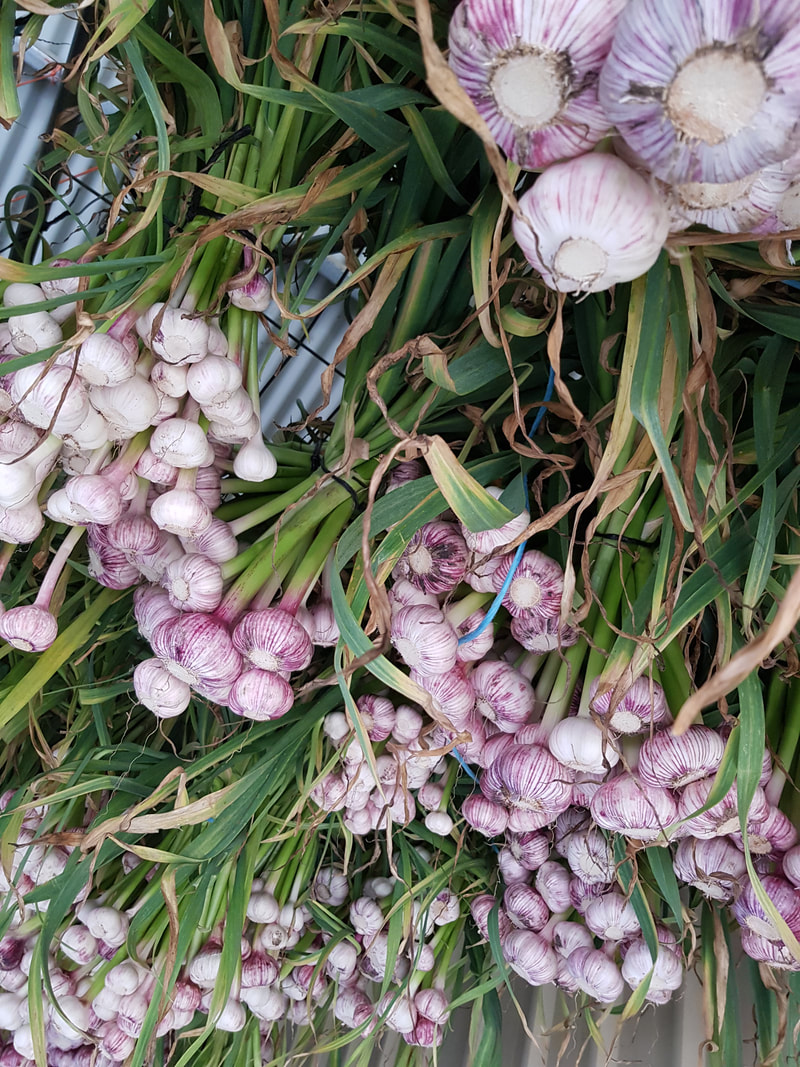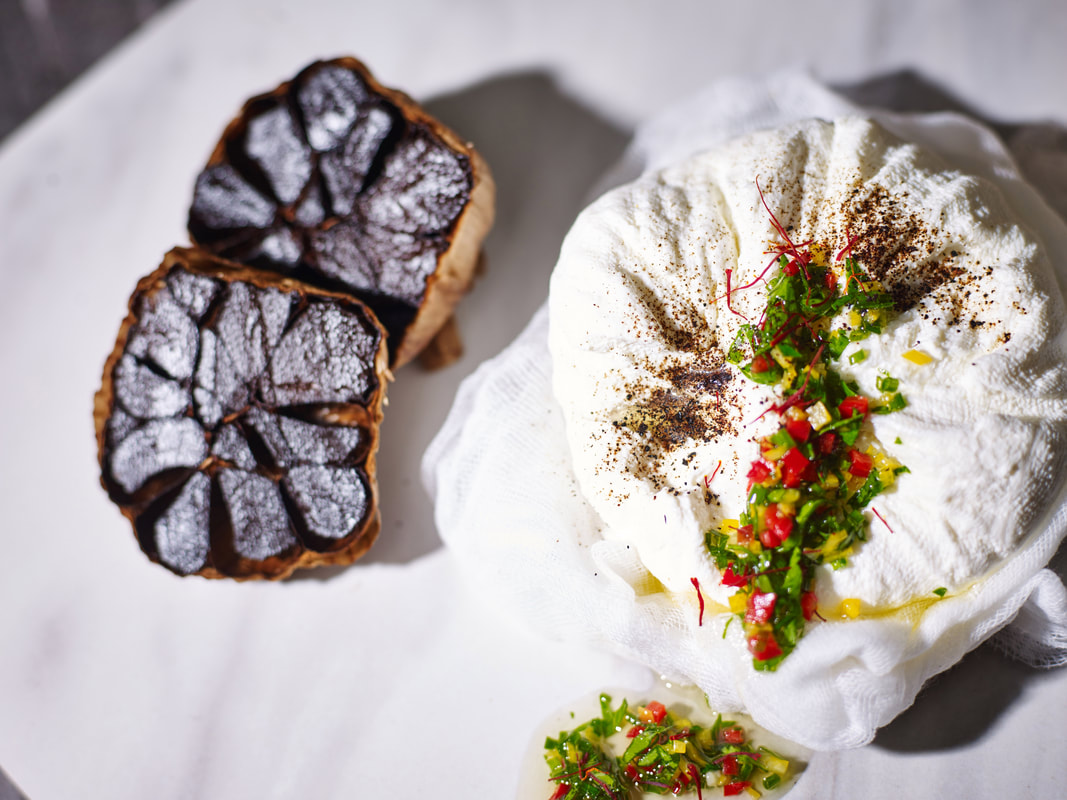|
You asked so here is the answer! Having just finished three days at the Good Food and Wine Show, this is a common question. Garlic is a versatile ingredient used in cuisines around the world for its pungent flavour and numerous health benefits. However, black garlic has emerged as an intriguing alternative to regular garlic, offering a distinct taste and potential additional advantages. In this blog post, we'll compare black garlic and regular garlic, exploring their differences in flavour, nutritional content, and culinary use. Flavour Profile: Regular Garlic: Fresh garlic is known for its sharp, pungent, and sometimes spicy flavour. It has a pronounced "bite" that can vary in intensity depending on the variety and freshness of the garlic. When cooked, regular garlic develops a mellow and slightly sweet flavour. Black Garlic: Black garlic undergoes a oxidation process that transforms its flavour profile. We take beautiful hard neck ‘Monaro Purple’ garlic with white flesh through a 30 day low slow “cook” to transform to black garlic. The pungency and spiciness of regular garlic are mellowed, giving way to a unique combination of savoury umami, caramel-like sweetness, and hints of balsamic and molasses. Garlic notes come through the flavour after the initial sweetness. Black garlic offers a more complex and subtle flavour compared to regular garlic. Nutritional Content: Regular Garlic: Fresh garlic is highly regarded for its nutritional value. It is a good source of vitamins C and B6, manganese, and selenium. Garlic is also known for containing sulphur compounds, such as allicin, which is associated with various health benefits, including potential immune-boosting and cardiovascular effects. Black Garlic: While the transformation of white to black garlic cause some changes in its nutritional composition, it still retains several beneficial compounds found in regular garlic. Black garlic has higher antioxidant levels than fresh garlic, offering enhanced antioxidant benefits. Additionally, black garlic contains S-allyl cysteine, a compound associated with heart health benefits. The reduced allicin levels make black garlic more easily digested. Culinary Use: Regular Garlic: Fresh garlic is widely used in cooking for its strong flavour and aroma. It is a staple in lots of savoury dishes, including stir-fries, sauces, soups, marinades, and roasted or grilled meats and vegetables. The pungency and spiciness of regular garlic can add depth and character to a wide range of recipes. Black Garlic: Black garlic's unique flavour makes it a versatile ingredient for culinary experimentation. Don’t use it in place of fresh garlic – don’t chop finely and fry off early in a dish. All you will have is little burnt black dots! Add black garlic towards the end of a dish, stirring through pasta or risotto. The warmth will bring out the rich flavour offering that finishing touch to your cooking. Black garlic pairs well with both savoury and sweet ingredients, making it suitable for sauces, dressings, pasta dishes, risottos, and even desserts. Its rich umami notes can enhance the complexity of flavour creating a memorable dish. Shelf Life:
Regular Garlic: Fresh garlic bulbs have a relatively short shelf life. They can typically be stored for a few weeks to a couple of months when kept in a cool, dry place. However, they may begin to sprout or deteriorate over time. Black Garlic: Black garlic has a significantly longer shelf life compared to regular garlic. The oxidation process contributes to its stability, allowing it to be stored for several years. Proper storage in a cool and dry environment helps maintain the quality and flavour of black garlic. Conclusion: While regular garlic and black garlic both have their unique qualities, they offer distinct flavours and culinary experiences. Regular garlic provides a bold and pungent taste, while black garlic offers a more complex and sweet umami profile. Additionally, black garlic retains beneficial compounds found in regular garlic and provides enhanced antioxidant and heart health benefits. Whether you choose regular garlic for its robust flavour or black garlic for its intriguing taste and potential additional advantages, both varieties can be valuable additions to your culinary repertoire.
0 Comments
Black garlic, with its unique flavour profile and rich umami notes, offers a wonderful opportunity to enhance your culinary creations. In this blog post, we'll explore some delicious recipes and flavour pairings that can help you make the most of this exceptional ingredient. Black Garlic Butter: Black garlic butter is a versatile and delicious condiment that can be used in various dishes. To make it, simply blend softened butter with mashed black garlic cloves until well combined. This flavourful butter can be spread on bread, used to sauté vegetables, melted over grilled steak, or added to pasta dishes for a burst of savoury richness. Our black garlic butter image (on Pinterest) is our most popular pinned image! Black Garlic Aioli: Upgrade your traditional aioli with the addition of black garlic. Mix mayonnaise, crushed black garlic cloves, lemon juice, and a pinch of salt until smooth and creamy. This black garlic aioli can be served as a dipping sauce for fries, a spread for sandwiches, or a tasty accompaniment to seafood and roasted vegetables. We offer a ready to go black garlic aioli if that tempts you. Black Garlic Salad Dressing: Create a unique and tangy salad dressing by combining black garlic, olive oil, balsamic vinegar, Dijon mustard, honey, and a touch of salt and pepper. This dressing pairs well with mixed greens, roasted beets, goat cheese, and toasted nuts, adding depth and complexity to your salads. Start with our White Balsamic Black Garlic dressing as your base. Black Garlic Marinade: Black garlic can be used to make a flavourful marinade for meats and vegetables. Combine minced black garlic, soy sauce, honey, ginger, sesame oil, and a splash of rice wine vinegar. Marinate your choice of protein or vegetables for a few hours or overnight before grilling, roasting, or stir-frying. The result is a tender and well-seasoned dish with a unique twist. Black Garlic Pasta: Incorporate black garlic into your pasta dishes for a burst of flavour. Sauté minced black garlic in olive oil until fragrant, then toss it with cooked pasta, grated Parmesan cheese, and a sprinkle of red pepper flakes. For an extra touch, add roasted cherry tomatoes, fresh herbs, and a drizzle of black garlic-infused olive oil. Go all out and add black garlic to your pasta dough. Black Garlic Soup: Add depth and richness to your soups with black garlic. Sauté diced onions, carrots, and celery in a pot, then add vegetable or chicken broth, black garlic, and your choice of herbs and spices. Simmer until the flavours meld together, then blend until smooth for a velvety black garlic soup. Garnish with a swirl of cream or a sprinkle of fresh herbs. Flavour Pairings: Black garlic pairs well with a range of ingredients, enhancing their flavours. Some excellent combinations include:
Cooking with black garlic opens up a world of possibilities, allowing you to create dishes that are both delicious and unique. Whether you're making sauces, marinades, dressings, or incorporating it into pasta dishes or soups, black garlic's deep umami flavour and caramelized sweetness can elevate your culinary creations to new heights. So, get creative, you can let your imagination run wild. Introduction: Black garlic, often referred to as "black gold," is a unique culinary ingredient that undergoes a fascinating transformation through a process known as ageing. This article delves into the art of ageing garlic and explores how time and controlled conditions turn ordinary garlic cloves into a prized delicacy. Getting Started: A key first step is to grown beautiful white garlic. We use a purple hard neck Monaro garlic that grows well in our area. It is that beautiful garlic with white skins and fine purple veins that you see in quality fruit stores. This variety has an ideal sugar content producing beautiful full flavoured black garlic. Understanding the Process: The transformation of garlic into black garlic involves a slow, natural oxidation process. Although often described as fermentation, which typically involves the action of microorganisms, black garlic is made through a controlled enzymatic reaction. Whole bulbs of garlic are placed in a humid, temperature-controlled environment, typically around 60°C, for an extended period, typically ranging from two to six weeks. This low and consistent heat triggers enzymatic reactions within the garlic, resulting in the gradual caramelization of natural sugars and Maillard reactions that give black garlic its characteristic dark colour, soft texture, and complex flavour profile. Flavour and Aroma Profile: One of the most intriguing aspects of black garlic is its flavour and aroma. During the ageing process, the pungent and sharp flavours commonly associated with raw garlic mellow and transform into something entirely different. Black garlic offers a unique umami taste with hints of sweetness, tanginess, and even notes of balsamic vinegar and molasses. Its aroma is often described as earthy, with hints of garlic, caramel, and fermented fruits. These flavour and aroma profiles make black garlic a versatile ingredient that can enhance a wide range of dishes. Culinary Uses: Black garlic's unique flavour profile makes it a prized ingredient in culinary creations. Its sweet, tangy, and umami taste can enhance both savoury and sweet dishes. Black garlic can add flavour in sauces, dressings, marinades, and soups. It can also be mashed and spread onto bread or incorporated into dips and spreads. Additionally, black garlic pairs well with meats, seafood, roasted vegetables, cheese and even desserts like chocolate or ice cream, adding depth and complexity to the overall dish. Availability and Storage: While black garlic was once relatively uncommon and difficult to find, its popularity has grown, and it can now be purchased in specialty food stores, gourmet markets, or online. When purchasing black garlic, look for plump and soft cloves with a glossy, black exterior. Proper storage is essential to maintain its quality. It is best stored in a cool, dry place, away from direct sunlight, and can typically be kept for several years.
Conclusion: The art of ageing garlic into black gold is a remarkable process that transforms the ordinary into something extraordinary. Black garlic's unique flavour, aroma, and potential health benefits make it a sought-after ingredient for culinary enthusiasts and health-conscious individuals alike. Whether you use it to elevate your home-cooked meals or experiment with new and exciting recipes, black garlic is a culinary treasure that showcases the magic of time and transformation. |
Archives
May 2024
Categories
All
|













 RSS Feed
RSS Feed
